JFK files: government releases classified assassination documents
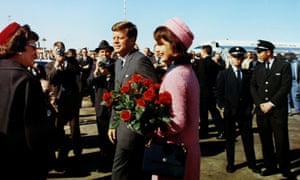
Catch the Live Updates by Guardian:
https://www.theguardian.com/us-news/live/2017/oct/26/jfk-files-released-assassination-documents-conspiracy-theories
FBI 'warned Dallas of death threat to Oswald'
The FBI had warning of a potential death threat to Lee Harvey Oswald, according to a memo by director J Edgar Hoover, which reveals some of the bureaus reactions to the assassination.
“There is nothing further on the Oswald case except that he is dead,” Hoover begins. “Last night we received a call in our Dallas office from a man talking in a calm voice and saying he was a member of a committee organized to kill Oswald.
“We at once notified the chief of police and he assured us Oswald would be given sufficient protection. This morning we called the chief of police again warning of the possibility of some effort against Oswald and again he assured us adequate protection would be given. However, this was not done.”
Hoover admitted that he does not have “firm” information about the man who shot Oswald dead, Jack Ruby, but nonetheless declared that his real name was Rubenstein, noted rumors of “underworld activity” suggested he had “the reputation of being a homosexual”.
The FBI sent an agent to Oswald’s deathbed in the hopes of a confession, to no success. Ruby denied making any phone call.
But then Hoover said that he and Nicholas Katzenbach, the deputy attorney general, already feared the spread of rumors and conspiracy theories. He noted that Oswald had visited Mexico City, called the Cuban embassy there, and sent a letter to the Soviet embassy about a visa.
“The thing I am concerned about, and so is Mr. Katzenbach, is having something issued so that we can convince the public that Oswald is the real assassin,” Hoover said.
h/t to reader Michael White, in New Jersey, for alerting us to the memo.
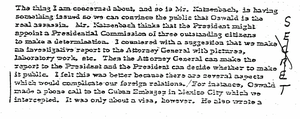
In two other memos, dated to August and September 1963 – before the assassination – an agent with the FBI’s New Orleans division wrote that agents had lost track of Oswald and were looking for him, especially in the Dallas area.
h/t to reader Jess O’Neill, in Australia, for the find.


Updated
In a mirror of his American counterparts, one Soviet leader, in particular, was convinced that the KGB needed to get to the bottom of some kind of wide-ranging plot to destabilize the US.
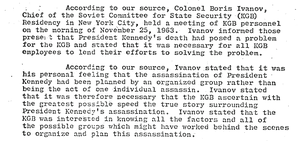
In 1965, a source told the FBI that the KGB had “data purporting to indicate president Johnson was responsible for the assassination” – meaning at least some Soviets were convinced of a conspiracy years after Oswald’s death and the Warren Commission.
The FBI pressed a KGB defector, Yuri Nosenko, for more information about what relation Oswald may have had with the with the USSR. Nothing worth anything, Nonsenko told them.
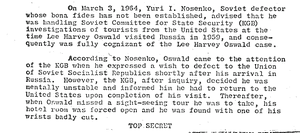
1966 FBI doc: Soviets declared Oswald 'maniac'
In one particularly striking FBI document, from director J Edgar Hoover, the agency details everything it has learned about the Soviet reaction to the JFK’s assassination, and what its agents might have known about Lee Harvey Oswald.
The Soviets, like many Americans, were convinced of a conspiracy.

They were also frightened that a panicked, reactive military would lash out at the USSR, and desperately wanted to learn more about what kind of person Lyndon Johnson was.
Our source further stated that Soviet officials were fearful that without leadership, some irresponsible general in the Untied States might launch a missile at the Soviet Union. It was the further opinion of the Soviet officials that only maniacs would think that the “left” forces in the United States, as represented by the Communist Party, USA, would assassinate President Kennedy, especially in view of the abuse the Communist Party, USA, has taken from the “ultraleft” as a result of its support for the peaceful coexistence and the disarmament policies of the Kennedy administration.
They declared Lee Harvey Oswald a “neurotic maniac who was disloyal to his own country and everything else”. They disclaimed him entirely.

Updated
Advertisement
A huge swath of the CIA files are receipts and financial accounts for clandenstine projects: tens of thousands of dollars paid out for anti-communist activities, supplies, and weapons, especially to people in Latin America.
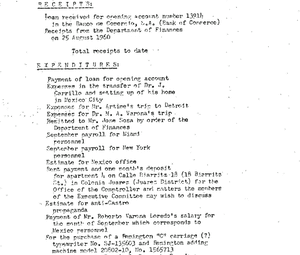
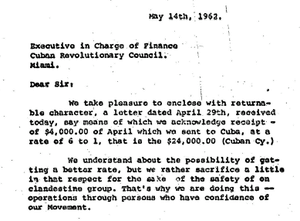
Since you’re here … we have a small favour to ask. More people are reading the Guardian than ever but advertising revenues across the media are falling fast. And unlike many news organisations, we haven’t put up a paywall – we want to keep our journalism as open as we can. So you can see why we need to ask for your help. The Guardian’s independent, investigative journalism takes a lot of time, money and hard work to produce. But we do it because we believe our perspective matters – because it might well be your perspective, too.
If everyone who reads our reporting, who likes it, helps fund it, our future would be much more secure. You can give to the Guardian by becoming a monthly supporter or by making a one-off contribution. - Guardian HQ
In a set of documents from the 1960s investigation, FBI staff are grilled by a Senate committee about their failure to stop Lee Harvey Oswald after his six-day trip to Mexico City in September 1963.
An FBI agent testified “Oswald wrote me in early 1962 to help expedite an exit visa for his wife. why in the world would he tell a plopper like that?”
A senator replies: “In any event, he told what the agent knew was lies, and what I am trying to get at is there was no analysis within the bureau of any of this. He even goes to Mexico City, contacts the Cuban consulate and the Soviet embassy, happens to be in contact – we don’t know if there is anything sinister about it – with an agent who is known to be KGB by the FBI and by the CIA, and suspected of being Department 13, which is their assassination and sabotage squad.
“In any event, he then returns to the United States, is never again interviewed by the FBI.”
Many of the documents read first and foremost as the 1960s artifacts they are: obsessed with communism, civil rights, and Vietnam.
In one, the CIA takes note of an article declaring that Martin Luther King “was right” about the Vietnam war. Another describes a “black power conference” that civil rights activist Adam Clayton Power wanted to hold, but “no one showed up”. A third concerns Stokley Carmichael,’s remarks of solidarity with a Latin American group.
There is are multiple transcripts of interrogations of Yuri Nosenko, a KGB defector. In one, Nosenko and his interrogator discuss Stalin, and rumors that the Soviet leader had his wife murdered, and then visited her grave.



Updated
Returning to the CIA report on plans to overthrow the Castro regime in the 1960s, the agency outlined a proposal to airdrop leaflets encouraging the killings of various communist officials.
“Leaflets will be designed to indicate phases. For example, the first leaflets will contain only names of communist leaders; the next leaflets will revise the names by job; i.e. cell leader, informer, party members, etc.; any of the above or subsequent leaflets will announce the amount of the reward, how and where it may be collected. One final leaflet may be deemed advisable and that one announcing a .02c reward for the delivery of Castro.”
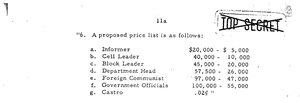
Advertisement
In a set of 1967 CIA documents, the agency lays out a report on Martin Luther King Jr.
In it, the agency considers whether there might be links between the civil rights movement and communism. It notes that a 4 November 1964 Washington Post article “stated that subject [King] was planning a visit to the Soviet Union. He reportedly had been invited to the USSR, but Rev Ralph Abernathy, spokesman for subject, refused to comment on the source of the invitation.
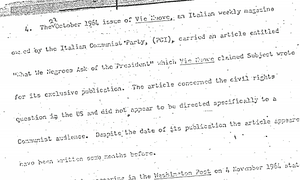
Another CIA document about a “black militant situation” in Chicago, says that one of its sources, “A”, believed King “sought at least constructive, positive projects”.

Updated
In another document from 1975, Bobby Kennedy, JFK’s brother and attorney general, is said to have become “unhappy” about attempts on Castro’s life.
Lawrence Houston, one of the men who helped establish the CIA, testified that around 1963, “he felt he was making a very strong drive to try to get after the Mafia. And so his comment was to us that if we were going to get involved with the mafia, in the future at any time, to make sure you see me first.”
Many of the documents pertain to anti-Cuban efforts by the US government in the 1960s and 70s, including “Operation Mongoose”.
In this 1962 file, the CIA considers “the possibility of producing crop failures by the introduction of biological agents which would appear to be of natural origin.”
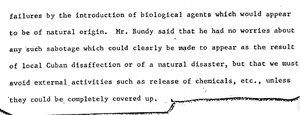
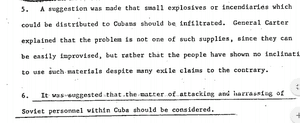
At least one document, a 1975 “summary of facts” details various CIA attempts to assassinate foreign leaders – part of the line of inquiry into whether the JFK assassination was planned by Cuba or the USSR.
Fidel Castro is front and center in the file; many historians have documented the various attempts on his life by the agency. The document says the CIA tried considered working with “mafia resources”, among other means.
The commission has determined that agents of the CIA were involved in planning in this country with certain citizens and others to seek to assassinate [Cuban] Premier [Fidel] Castro. The commission has also determined that the CIA was involved in shipping arms from this country to persons in the Dominican Republic, who sought to assassinate Generalissimo Trujillo (who himself had been involved in an attempt to assassinate the president of Venezuela.) [sic]The commission has not found evidence of any other attempts to assassinate any other foreign leader which had significant overt activities within the United States. However, the nature of the activity and the degree of secrecy and compartmentation within the agency is such that it is difficult to find evidence of this kind unless specific facts are brought to the attention of an investigating body.”
According to the document, the CIA considered killing Congolese leader Patrice Lumumba and Indonesian president Sukarno, as well.
Archives release documents
The National Archives have released 2,891 previously secret files related to the JFK assassination, which you can download and look through here.
We’ll begin searching through them now, and uploading documents with context to the blog.
Advertisement
Only a few hours before a 25-year deadline was set to expire, the White House confirmed that it would release nearly 3,000 previously secret documents related to the 1963 assassination of John F Kennedy.
We’re now waiting on the National Archives to upload the documents online, which was promised shortly after a presidential memo. We’ll start sifting through them as soon as they’re available.
In that memo, Donald Trump blocked the release of an unknown number of files, saying he had “no choice” but to accept the concerns of agencies such as the FBI and CIA. For days, he had hyped the release of the documents as a victory for the public that would be “so interesting!”
On Thursday, though, he said that he had to bow to “national security, law enforcement, and foreign affairs concerns” raised by the agencies. He ordered a 180-day review for the agencies to reconsider their redactions, meaning another deadline for documents: 26 April 2018.
Officials said they would not comment on conspiracy theories, including one propagated by Trump, about the father of a sitting senator. “Honestly we’re not going to comment on the content of the files,” the official said. “It’s the practice of the National Archives to leave it up to the researchers.”
We’d like your help too. The JFK files will be published online here. If you’re reading through the documents and you spot an interesting fact or snippet you think we’ve missed, it would be great if you could let us know. We’ve set up a form here for contributions.
Trump: I have no choice but to keep files secret
The White House has released the memo signed by Donald Trump to release some 2,800 documents and keep another several hundred secret.
“I have no choice – today – but to accept those redactions rather than allow potentially irreversible harm to our Nation’s security,” the president says.
You can read the entire memo, including the president’s order to review the classified status of documents over the next 180 days, below.
The American public expects -- and deserves -- its Government to provide as much access as possible to the President John F. Kennedy Assassination Records (records) so that the people may finally be fully informed about all aspects of this pivotal event. Therefore, I am ordering today that the veil finally be lifted. At the same time, executive departments and agencies (agencies) have proposed to me that certain information should continue to be redacted because of national security, law enforcement, and foreign affairs concerns.I have no choice --today -- but to accept those redactions rather than allow potentially irreversible harm to our Nation’s security. To further address these concerns, I am also ordering agencies to re-review each and every one of those redactions over the next 180 days. At the end of that period, I will order the public disclosure of any information that the agencies cannot demonstrate meets the statutory standard for continued postponement of disclosure under section 5(g)(2)(D) of the President John F. Kennedy Assassination Records Collection Act of 1992 (44 U.S.C. 2107 note) (the “Act”).Accordingly, by the authority vested in me as President and Commander in Chief by the Constitution and the laws of the United States of America, I hereby certify that all information within records that agencies have proposed for continued postponement under section 5(g)(2)(D) of the Act must be temporarily withheld from full public disclosure until no later than April 26, 2018, to allow sufficient time to determine whether such information warrants continued postponement under the Act.This temporary withholding from full public disclosure is necessary to protect against harm to the military defense, intelligence operations, law enforcement, or the conduct of foreign relations that is of such gravity that it outweighs the public interest in immediate disclosure.I hereby direct all agencies that have proposed postponement of full disclosure to review the information subject to this certification and identify as much as possible that may be publicly disclosed without harm to the military defense, intelligence operations, law enforcement, or conduct of foreign relations.Any agency that seeks to request further postponement beyond this temporary certification shall adhere to the findings of the Act, which state, among other things, that “only in the rarest cases is there any legitimate need for continued protection of such records.” The need for continued protection can only have grown weaker with the passage of time since the Congress made this finding. Accordingly, each agency head should be extremely circumspect in recommending any further postponement of full disclosure of records.Any agency that seeks further postponement shall, no later than March 12, 2018, report to the Archivist of the United States (Archivist) on the specific information within particular records that meets the standard for continued postponement under section 5(g)(2)(D) of the Act. Thereafter, the Archivist shall recommend to me, no later than March 26, 2018, whether the specific information within particular records identified by agencies warrants continued withholding from public disclosure afterApril 26, 2018.The Archivist is hereby authorized and directed to publish this memorandum in the Federal Register.
Hello and welcome to our rolling coverage of 2,800 previously classified documents related to the 1963 assassination of president John F Kennedy, a publication with over half a century of speculation, films, novels and conspiracy theories riding along.
A White House official told reporters that the president blocked the release of few hundred records, at least temporarily. Earlier on Thursday president Donald Trump approved requests, mostly by the FBI and CIA, to keep those documents hidden “because of the national security, law enforcement and foreign affairs concerns,” the official said.
Trump ordered the agencies to review those redaction over the course of six months, the official said, to ensure more documents reach the public. The official said he had “no choice” but to accept the agencies’ concerns for the time being, but that he wanted “the veil finally be lifted”.
The National Archives release was mandated by a 1992 law, which set a deadline of 26 October 2017, 54 years after Kennedy was killed by a sniper in Dallas, Texas. Donald Trump has chosen not to block the release of thousands of documents, unless intelligence agencies “provide a compelling and clear national security or law enforcement justification otherwise,” the White House said.
The president seemed excited about the release on Wednesday evening, tweeting:
The long anticipated release of the #JFKFiles will take place tomorrow. So interesting!
The documents, numbering around 3,150, are largely a mystery. But researchers do not think they will change the findings of the Warren Commission, tasked in 1963 and 1964 to investigate the assassination. That panel found that Lee Harvey Oswald, a former US marine and then defector to the Soviet Union, was the sole gunman. Oswald was himself murdered while in custody, by Dallas nightclub owner Jack Ruby.
A House panel, in 1979, cast skepticism on the thoroughness of the first investigation, and considered it “likely” that some kind of conspiracy was at work, perhaps involving a second shooter on “the grassy knoll”. The committee’s findings opened the door for theories about the CIA, Cuban or Soviet agents and the mafia.
Officials said on Thursday that they would not comment on conspiracy theories, including one propagated by Trump, about the father of a sitting senator. “Honestly we’re not going to comment on the content of the files,” the official said. “It’s the practice of the National Archives to leave it up to the researchers.”
But the panels’ findings have not deterred private sleuths, the president’s preferred tabloid among them. Many citizen investigators point to Oswald’s six-day excursion to Mexico City, to meet with Cuban and Soviet agents before the assassination, or the short “Zapruder film”, a video made by the handheld camera of Abraham Zapruder. The ambiguity within that video other circumstances of Kennedy’s death have led to a film by Oliver Stone, a novel by Don DeLillo, and scores of documentaries and citizen conspiracies.
The president espoused one such conspiracy theory during his 2016 campaign, telling Fox News in an interview that the father of a rival, senator Ted Cruz, “was with Lee Harvey Oswald prior to Oswald’s being, you know, shot.”
“The whole thing is ridiculous,” Trump said. “What is this, right, prior to his being shot, and nobody brings it up. They don’t even talk about that. That was reported and nobody talks about it. But I think it’s horrible.”
Before and during the campaign, Trump also spread the false conspiracy theory that Barack Obama was not born a US citizen, and the internet myths that an American general fought Islamic terrorists by dipping bullets in pig’s blood and that “thousands” of Muslims in New Jersey cheered the terrorist attacks of September 11 2001.
Conspiracies aside, the newly released documents could provide a trove of new information for historians to pore over, as formerly secret documents related to Kennedy’s presidency have already done in recent years. We’ll be poring through the material here, with expert assistance and reporting from Tom Dart in Dallas.
We’d like your help too. The JFK files will be published online here. If you’re reading through the documents and you spot an interesting fact or snippet you think we’ve missed, it would be great if you could let us know. We’ve set up a form here for contributions.









